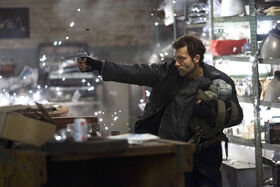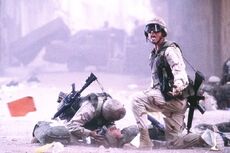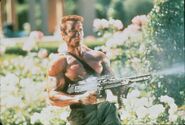History of Action in Cinema

Early shootout featured in The Great Train Robbery (1903)
Not long after its creation, cinema gave birth to the action sequence. As far back as 1903, The Great Train Robbery featured a shootout in the wake of a heist. However, while a number of films in the first half of the 20th century featured action-oriented elements ranging from battles to gun fights, films generally did not begin to prominently feature it until the 1960's. This was roughly the time Westerns like The Wild Bunch(1969) and Butch Cassidy and the Sundance Kid (1969) began using more and more elaborate shootouts. James Bond, having been introduced to the world in Dr. No circa 1962, also popularized the genre. The memorable Bullitt (1968) further helped to establish the now prominent position of action in film, delivering a car chase still highly revered today.

Bullitt (1968)
Asian cinema should also be noted for its contributions to the genre. They include martial arts, stylized shootouts, and Heroic Bloodshed. Action films themselves are characterized by and boast any number of exciting conflict-based spectacles. These are often of a violent and/or dangerous nature.
The action sequence, in whatever form it might take, has evolved significantly over the past few decades, and today the results of that evolution are readily visible in any number of motion pictures.
The Shootout

Say hello to his little friend - Scarface (1983)
Since the start of the 20th century, shootouts have captured the attention of audiences the world over. Remaining a key ingredient in action films, armed confrontation is used widely today in a myriad of styles and ways.
Though the first examples were created long ago, gunfights did not begin to take a prominent place in moviedom until they became a staple of the Western in the 1950's and 60's. Ranging from standoffs in Leone's Spaghetti Westerns to all-out gunfire in films like Butch Cassidy and the Sundance Kid (1969), this type of sequence drastically increased in popularity with audiences of the time. Gunfights became more and more elaborate in the Western, and some filmmakers took steps to heighten the realism depicted therein. For instance, whereas most films up to this time simply showed actors reacting to being shot, The Wild Bunch (1969) employed nearly 10,000 squibs to simulate the blood associated with gunshot wounds (Felchner).

Actors like Jason Statham and Clive Owen (pictured here) have helped to fill the "tough guy action hero" void left by Schwarzenegger, Stallone, and to a lesser extent Willis - Shoot 'Em Up (2007)
A number of non-Westerns of the era also began to popularize the shootout - and guns in general - including Bonnie and Clyde (1967) and Dirty Harry (1971). And as these films transitioned audiences into the 70's, a number of movies began to extensively employ guns. 1972's The Getaway featured Steve McQueen blasting away at a squad car with a shotgun as well as a bloody confrontation in a Texas hotel. The Gauntlet (1977) depicted extensive gunfire at and around Eastwood's character. The Bond film The Man with the Golden Gun (1974) went so far as to make a gun a key plot element, ending with a cat and mouse confrontation between Bond and another gunman.
The 80's saw the rise of the One Man Army action sub-genre, and to compensate for a lack of gunman action icons like Schwarenegger and Stallone would dispatch innumerous baddies with machine gun fire. Action heroes' newfound and uncanny ability to never sustain any serious injuries also gave rise to the lack of realism many 80's action films are known for. This borderline cartoony depiction of violence was furthered by Hong Kong director John Woo's development of gun fu, a hyperkinetic combination of martial arts-esque stunts like dives, rolls, and even flips combined with guns, often two pistols at a time. This innovative take on the shootout has had much influence on the action genre since, and a number of modern directors continue to mimic the styles created by Woo.
The 90's and 2000's have not been dominated by any definitive shootout characteristics, but rather have become two decades exhibiting a plethora of styles and levels of realism surrounding gunfights. The era has seen action ranging from Robert Rodriguez's One Man Army gun fu El Mariachi movies to Michael Mann's depiction of realistic armed conflict in Heat (1995) to the Wachowskis' borderline surreal Matrix films to the AK-47 v. M16 battles seen in Ridley Scott's Black Hawk Down (2001).
The Car Chase

Ronin (1998)
Though there were examples of automobile pursuits in earlier films, the first "modern" car chase was featured in Peter Yates' famous Bullitt (1968). The movie featured a Steve McQueen-driven Ford Mustang pursuing a '68 Dodge Charger; the chase ends with the Charger crashing and exploding, two more elements used extensively in future sequences. 1971's The French Connection depicted another famous pursuit, this time with Gene Hackman behind the wheel. The popularity of these movies' car chases inspired many future films to also feature them. McQ (1974) took the car chase one step further, ending its own with a rollover, something that hadn't yet been seen in film.

Vanishing Point (1971) - the entire film centers on an extended cross country chase
Throughout the 80's and 90's, chases became increasingly elaborate. They featured more and more stunts, crashes, and even included shooting from one car at the other, an element of the chase utilized on occasion in earlier films like Bullitt (1968) and Some Like it Hot (1959). It became the norm for exotic sports cars to be the used, and a number of editing techniques were developed to heighten suspense and excitement during chase sequences.
Computer generated imagery has further allowed filmmakers to present stunts that that may have been too dangerous to actually film. While some critics contend CGI reduces realism and therefore believability and excitement in chase scenes, it continues to be employed for either budgetary reasons or safety concerns, and on occasion both.
The Fight Scene

Tony Jaa kicks butt in Ong-bak (2003)
While swashbuckler sword fighting had been seen as early as the silent film era, hand-to-hand combat was not used in any extensive mainstream capacity until popularized by Hong Kong action stars like Bruce Lee and Jackie Chan in the 1970's. Well received, filmmakers the world over began to incorporate similar sequences into their films.
The 80's saw the rise of less acrobatic but bigger and more muscly action stars. Typically these Van Damme-esque heroes were found in American and European cinema, while Asian martial arts films remained dominated by stars like Chan.
More recently, stars like Jet Li, Tony Jaa, Jason Statham, and Wesley Snipes have taken the spotlight. Statham is especially notable in that he brings brawn and martial arts together, bridging the

Statham squares up with opponent - The Transporter (2002)
fighting style divide most action stars find themselves on either side of. Wire fu has also gained prominence in fights, allowing characters in films like Hero (2002) and Kill Bill (2003) to jump higher or dive further than a human naturally could.
Today, many action movie protagonists are learned in one form of martial arts or another. Jason Bourne (Matt Damon), Frank Martin (Jason Statham), and Neo (Keanu Reeves) have all beaten outnumbering opponents using their proficiency in hand-to-hand combat. Other characters like James Bond have less refined fighting skills, but they still manage to get the job done through brute force, resourcefulness, or perhaps by simply getting to a gun first.
The War Movie

Alexander Nevsky's (1938) ice battle
Battle sequences are an inherent element of war movies, battle being an inherent element of war. Ranging from shield and spear to battle ship on battle ship to nuclear confrontation, the war movie can take on many shapes and sizes, but action is a universally common feature.
World War I was the source of inspiration for many early war movies including the famous All Quiet on the Western Front (1930). War-related subject matter was also the focus of World War II era propaganda films, the Soviet made Alexander Nevsky (1938) being one such example.
World War II spawned a number of further war movies throughout the 50's and 60's. Vietnam had a similar effect on filmmakers, leading to films like Apocalypse Now (1979), Platoon (1986), and Full Metal Jacket (1987).

American soldiers caught up in the Somali Civil War - Black Hawk Down (2001)

The Last of the Mohicans (1992) depicts the violence of the French and Indian War
Today, war movies have been inspired by recent conflicts that include the Gulf War, the Somali Civil War, and the Bosnian/Serbian conflict as well as older ones that range from the Battle of Thermopylae to the Siege of Jerusalem in 1187 to virtually any war in the last several hundred years.
War has also been an element of numerous fantasy films, examples being the Lord of the Rings trilogy and the Narnia franchise. Fictional accounts of war are not only limited to the fantasy genre; Alfonso Cuarón's Children of Men (2006) depicts a fictional conflict, though the film's story purports to take place within the "real world."
Luminaries of the Genre
Many filmmakers have worked within the action genre over the past several decades. Some have been innovators, others have simply utilized tried and true techniques or ideas, often while making efforts to hone and perfect them. Several are listed below.
John Woo

John Woo, a quintessential action director, on the set of Mission: Impossible 2 (2000)
First working in the industry as choreographed Hong Kong kung fu movies were becoming popular in the 1970's, Woo developed a keen sense of aesthetically pleasing movements in action sequences. Though he didn't find immediate success as a filmmaker, by the mid 1980's he began to extensively incorporate and build upon the cinematic influences that inspired him (including the stylistic movement found in martial arts films and the dual-wielding gunplay featured in any number of Westerns), resulting in his first major success, the Hong Kong blockbuster A Better Tomorrow (1986). The Heroic Bloodshed movie boasted hard-boiled, heroic protagonists as well as many of the techniques Woo would become famous for in future films: slow motion, firing two pistols at once, and gun fu. The Heroic Bloodshed subgenre deals with themes like honor, camaraderie, and redemption. It is generally associated with Hong Kong action cinema as well as gun fu. A Better Tomorrow II (1987), The Killer (1989), and Hard Boiled (1992), arguably Woo's magnum opus, were further examples of Heroic Bloodshed. Woo's style influenced many future filmmakers, including Robert Rodriguez, the Wachowski brothers, Kurt Wimmer, and others.
Woo made his career with his innovative approach to action. In the early 90's he transitioned from Asia to the United States. Here he began making more Americanized action movies, though still bringing his personal and unique touch. Starting with the Van Damme vehicle Hard Target (1993), Woo went on to make Broken Arrow (1996), Face/Off (1997), Mission: Impossible 2 (2000), Windtalkers (2002), and Paycheck (2003). Since this string of Western films, Woo has gone back to China to make the historical Red Cliff battle epics.
Michael Bay

Ferrari maneuvers through wreckage - Bad Boys II (2003)
Director Michael Bay found near instant success in his first theatrically released movie, the 1995 Will Smith/Martin Lawrence buddy cop blockbuster Bad Boys. Showing great promise, Bay quickly found his niche in the big budget summer action movie. Bay followed this initial success up with The Rock (1996), Armageddon (1998), and Pearl Harbor (2001). Revisiting his first theatrical effort, Bay made Bad Boys II in 2003; both Smith and Lawrence reprised their roles as buddy cop foils. His first real box office disappointment came in the form of 2005's The Island, though Bay made his return to form with the highly successful and lucrative Transformers (2007).
Bay's style could simply be described as "big." Though he occasionally borrows Woo's gun fu technique or finds inspiration in Mann's Miami Vice, Bay is an auteur who makes big, loud, explosive summer blockbusters. Though he has been the subject of criticism for epitomizing thoughtless entertainment, Bay's films continue to find sizable financial success and therefore have little chance of ending any time soon.
Luc Besson

Gary Oldman looks sinister - Leon/The Professional (1994)
French filmmaker Luc Besson has worked extensively within the action genre. Directing La Femme Nikita (1990), Leon (1994), and The Fifth Element (1997), Besson also has a plethora of writing and producing credits for action films. He has been involved in the Transporter franchise starring Jason Statham, the action comedy Taxi movies, the Jet Li films Unleashed (2005) and Kiss of the Dragon (2001), the highly stylistic Banlieue 13 (2004) as well as its sequel Banlieue 14 (2009), and the Tony Jaa Thai martial arts movie Ong-bak (2003).
Besson's movies tend to elicit a sense of European refinement and style, while at the same time boasting stylistic flair evocative of John Woo's work. And while there is some crossover between the two filmmakers' styles, Besson's action tends to be less bloody and violent than Woo's and generally features more martial arts.
Directors
- Michael Bay
- Luc Besson

Michael Mann on the set of Collateral (2004) with Jamie Foxx and Tom Cruise
- James Cameron
- Martin Campbell
- Rob Cohen
- Akira Kurosawa
- Louis Leterrier
- Michael Mann
- John McTiernan
- Wolfgang Petersen
- Robert Rodriguez
- Ridley Scott
- Tony Scott
- Steven Spielberg
- Wachowski bros.
- John Woo
- Corey Yuen
Actors
- Ben Affleck
- Antonio Banderas
- Nicolas Cage
- Jackie Chan
- Vin Diesel

Bruce Willis kicks terrorist butt in Nakatomi Tower - Die Hard (1988)
- Harrison Ford
- Mel Gibson
- Tony Jaa
- Dwayne Johnson
- Bruce Lee
- Jet Li
- Dolph Lundgren
- Chuck Norris
- Clive Owen
- Keanu Reeves
- Arnold Schwarzenegger
- Steven Seagal
- Will Smith
- Wesley Snipes
- Sylvester Stallone
- Jason Statham
- Jean-Claude Van Damme
- Bruce Willis
- Chow Yun-Fat
Future of Action Cinema
Conflict is the center of a story, and nothing epitomizes conflict better than an action film. Consequently, this popular cinematic genre won't be going away anytime soon. This is further evidenced by the box office enthusiasm for big budget summer blockbusters, movies chock-full of exciting action.
Yet as the action film evolves to fit the moods, values, and desires of society, as it meets modern technology in the form of CGI and ever-advancing special effects, and as it boasts increasingly elaborate action sequences, audiences will always find consistency in the basic underlying makeup of what they see. That is to say, shootouts, chases, fights, and battles will remain at the heart of the action film, even as the genre progresses forward.
Sources
Felchner, William J. "Movie: The Wild Bunch (1969)." Suite101. 19 June 2008. 3 Dec. 2008 <http://film-westerns.suite101.com/article.cfm/movie_the_wild_bunch_1969>.











